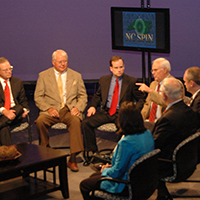Keep moving forward on housing
Published July 10, 2025
By John Hood
North Carolina continues to enjoy one of America’s fastest rates of population growth, adding some 165,000 new residents in 2024 alone. That was the fourth-largest numerical gain in the country and the seventh-largest rate of increase (1.5%), behind only Florida, Texas, Utah, South Carolina, Nevada, and Idaho.
While our birth rate is higher than average, most new North Carolinians move into the state from elsewhere. Only Texas experienced more net domestic in-migration last year.
Good news? Sure. Communities should always aspire to be places other people want to live — not places most folks would like to flee if possible (I’m looking at you, New York and Illinois). But more residents means demand for more residences. Over the past decade, North Carolina has built more housing than most of our competitors. That’s one of our competitive advantages. Still, too many of our housing markets are too tight.
Take Asheville. Even before Hurricane Helene struck, housing inventory was demonstrably inadequate. According to a new housing-market tracker from the American Enterprise Institute, the median price-to-income ratio for homes there is 7.1, compared to 5.7 in Hendersonville, 4.9 in Sylva, 4.4 in Morganton, and 4.1 in Hickory. AEI scholars Tobias Peter and Edward Pinto estimate Asheville’s housing shortage at 4,913 units, or 10% of existing units in the city.
Other constricted markets include the college towns of Boone and Chapel Hill (each with a housing shortage equivalent to about 10% of current inventory) along with Wilmington (6%), Durham (5.5%), Raleigh (5.2%), and Charlotte (5.2%). Greenville (4%), Cary (4%), Gastonia (4%), Concord (3.8%), Winston-Salem (3.3%) High Point (3.3%), Greensboro (3%), Jacksonville (2.7%), Apex (2.5%), and Fayetteville (.9%) are in better shape by this metric.
State and local policymakers have already taken steps to improve housing affordability in North Carolina. They’ve sped up construction permitting and, to some extent, deregulated the market for skilled labor. They’ve modified zoning codes to allow a greater diversity of options and more housing units per lot. And they’ve largely held the line or reduced tax rates on both income and property, increasing take-home pay in the first case and reducing the cost of renting or owning homes in the latter case.
It’s time to build on this early momentum, at all levels of government. In Washington, Congress and the Trump administration can reduce the extent to which federal subsidies boost prices at the high end of the market. Fewer than 10% of households, mostly wealthy, now itemize deductions on their income-tax returns, for example, and the evidence is overwhelming that the mortgage-interest deduction just incentivizes the building of larger homes. Similarly, most countries don’t use government-sponsored enterprises to buy home loans. America’s system increases cost and risk without boosting homeownership rates.
Congress should also rein in the administration’s recent tariff spree, which raises the cost of imports such as lumber and fixtures required to build economically.
At the local level, counties and municipalities should continue to reform housing and zoning codes. And at the state level, the General Assembly should send a clear message that respecting the right of private owners to buy, sell, and develop residential property is important not only in its own right but also to help North Carolina accommodate the population growth we’re already experiencing — and to make us a more attractive place to live, work, form families, and build businesses.
Senate Bill 497, for instance, would authorize denser housing options and prohibit localities from imposing “unreasonable costs or delay, including zoning, development, siting, or design review standards.” Two companion pieces of legislation would authorize accessory dwelling units statewide (Senate Bill 495) and make it easier to convert offices and storefronts into lofts, apartments, or other housing options (Senate Bill 499).
Is it a coincidence that the primary sponsors of these bipartisan bills, Republican Sen. Tim Moffitt and Democratic Sen. Julie Mayfield, happen to represent the Asheville region? Of course not. They and their constituents don’t have to foresee acute shortages. They’re already experiencing them.
John Hood is a John Locke Foundation board member. His books Mountain Folk, Forest Folk, and Water Folk combine epic fantasy and American history.







